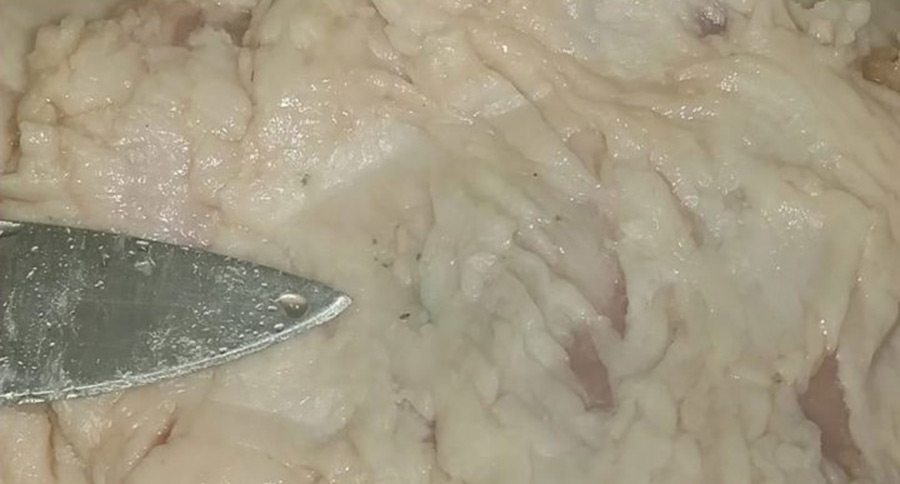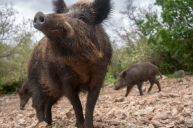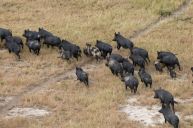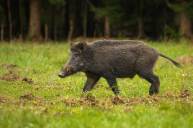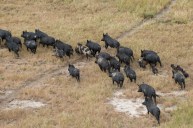Apparently Texas has not only a pig problem, but now a feral hog issue as well.
Around here, we think a venison steak tastes just as good as a New York strip, so it's no surprise that we keep up with the wild game reports in our area.
In Texas, the feral hog population has grown year after year (you can read more about that here) and per the Texas Parks and Wildlife Department, it's perfectly legal to hunt feral hogs with a hunting license all year long.
As John McAdams wrote, "They may be hunted over bait, trapped, hunted at night, and from aircraft... it's estimated that over three quarters of a million hogs are taken by hunters, trappers, and TPWD each year in Texas."
Because the population is growing wildly out of control, feral hog hunting has become increasingly popular, especially in the off season. However, if you or anyone you know hunts wild pigs in Texas, you'll want to let them know that the Gregg County AgriLife Extension Agency issued a warning after a green substance was found in the fat of a few feral pigs in Texas.
As reported by KXAN, "the meat that's contaminated is believed to contain larvae of Spirometra mansonoides — commonly known as the bobcat tapeworm. It can infect humans at this larval stage."
The group posted a warning on Facebook alerting the public, which was picked up by news outlets to spread throughout the state.
The text of the post issues this warning:
"This information comes from a very good County Agent friend of mine here in East District 5 and I wanted to pass this along. IF YOU LIKE TO EAT WILD PIGS, YOU NEED TO READ THIS...
I wanted to share this information on feral hogs. We all know what a problem they are in the District and State. We all have people in our Counties that harvest and consume feral hogs.
Last Thursday I received a phone call, in reference to pigs that had been processed and the fat of the meat had green specs imbedded in the fat. I tried to make the client tell me that he was seeing a blue color on the fat thinking the pigs may have eaten Warfarin. He then told me it was John Deere Green. I went to see for myself as you view the pictures you will see green color.
To make a long story short I made several calls to specialist, no one knew what was going on. Saturday morning I received a call from Dr. Tom Hairgrove Extension Veterinarian, he visited with Dr. Tom Craig Texas A&M College of Veterinary Medicine a Clinical Parasitology's he called it the larval of Spirometra mansonoide common name bob cat tapeworm it can infect Humans with this larval stage.
The bob cat tapeworm has also been found in domesticated cats in East Texas. Meat that is contaminated with this type of infection and prepared any way other than well done could infect people. In humans this worm goes to the brain and can cause issues."
While there's no information on just how widespread the tapeworm problem is, hunters are cautioned to use care when processing their hogs.
KXAN and KETK both reached out to The Gregg County Agrilife Extension and spoke to Randy Reeves, who said that even though most people don't eat hogs because they'll eat just about anything, the public should just be careful. "If you plan on eating your kill, cook it all the way through. Like a well done steak. Otherwise, you're putting yourself at risk.
Gregg County- Agrilife Extension Services went even further, posting this adviceto hunters out for hogs.
Wild Pig Concerns...
I am sure that all or most of you have received the information pertaining to the recent finding of the Spirometra mansonoide , Bobcat tapeworm, in wild pig tissue in east Texas. In our society information travels faster than what one would assume in many instances with this being an example. There are some aspects of the information surrounding the Bobcat tapeworm and wild pigs that needs to be addressed with regard to escalating public concern over the past several days.The finding of Spirometra mansonide (Bobcat tapeworm) in east Texas should not be of a serious concern due to the fact that the parasite is endemic to the region and can be found in both wild and domestic populations of cats and other intermediate and terminal hosts. As with other parasites in east Texas, this particular one should be something in which to be aware but not to keep you up at night. Though the Bobcat tapeworm can, in extremely rare cases, result in human health concerns does not justify fear; merely the need to be aware. Parasites are common in animal and fish species commonly consumed for table food. The key to removing any level of fear or concern is implementing proper observation and food handling and preparation techniques. When processing any wild or domestic species for the purposes of consumption, one should follow the following steps:
Wear proper protective equipment/gear. The safety reasons for needing the proper gear is obvious simply due to the use of knives, saws, and other processing tools is one aspect. Secondly is the protection for that which cannot be seen. Parasites, blood pathogens, infections, etc... can be present in meat being processed for food. In most every instance it is not visible so prevention of exposure is the best course of action.
Next is to use your best judgement if you should observe any abnormalities in the meat being processed. Should you find abnormalities in the color, texture, smell, etc... of the meat being processed you have decisions to consider. Do I throw the meat away? If there is doubt as to the safety of the meat - YES. It is never good to balk at a food safety decision and disposing of questionable meat should be your call. Could the abnormality be a result of something that occurred in the act of processing? This is a possibility. When an observed abnormality is thought to be a result of processing, ask the individual processing the meat. If you were the individual processing the meat, rethink your previous steps.
Lastly is proper preparation with regard to cooking. Only cook meat that is free of any safety concerns. Cook the meat thoroughly regardless of origin. Some like a beef steak rare. This should not be the decision when cooking wild pig pork. Cook the meat thoroughly to the point of will done. Proper cooking techniques will remove virtually all concerns associated ingestion of something harmful.
Yes, wild pigs are everywhere throughout east Texas with the entire region being prime habitat. It is somewhat common to encounter wild pig meat with abnormalities. The nature and diet of the species can explain the occurrences. Wild pigs are destructive in daily patterns from feeding to fighting, to eluding perceived predators. In their daily activities, they will stab themselves with various items that may result in local infections and discoloration of the meat. Furthermore, the wild pigs are in excess of 90% vegetation but will also eat almost anything. Feeding habits of wild pigs can place them in contact with food items that may be harboring undesirable additions. For this reason you should be vigilant at all stages of interaction with wild pigs.
In closing, currently there are no toxicants labeled for wild pig control. This means that there should be no cause for concern with regard to ingesting pharmaceuticals while consuming the meat of wild pigs.
Contact your local Texas A&M AgriLife Extension office for assistance in answering additional questions or concerns pertaining to this topic.
So be sure that all of your hunter friends in the area know about this potentially widespread problem and remember that if you're taking wild pig meat, treat it with the utmost care. Feral hog meat makes for some pretty good tacos, and tacos are always a good thing.
It's also important to note that when we're talking wild boar, we're not talking about domesticated pigs in the United States. Wild hogs run rampant on Texas farmland (it's even a problem in Europe) and can cause a great deal of property damage, resulting in their year-long open season in Texas. So before you have wild boar meat from the land this year, ask a few more questions than you normally might.
Post originally published on WideOpenEats.com.
NEXT: 3 OFF-THE-WALL NEW PRODUCTS FROM SHOT SHOW
